Sweet Pea Gnocchi with Tarragon Pea Cream
This recipe for Sweet Pea Gnocchi with Tarragon Pea Cream is elegant and beautiful to serve, not to mention it tastes amazing. It's the perfect recipe to serve in spring.
This post may contain affiliate links.
Over the past 7 years, gardening has become my number one most favorite hobby. I inherited my green thumb from my Momma, who also loved getting her hands dirty and watching things grow. My thumb started out brown, and while it's still far from a pure Kelly green, the shade gets a little brighter with each passing season.
This time of year, my heart flutters at the sight of little green sprouts finding their way out of the dirt. There's something so special (not to mention convenient) about waltzing barefoot into the backyard to pick a few fresh herbs to finish a dish, a head of lettuce for a salad, or a handful of strawberries to snack on.
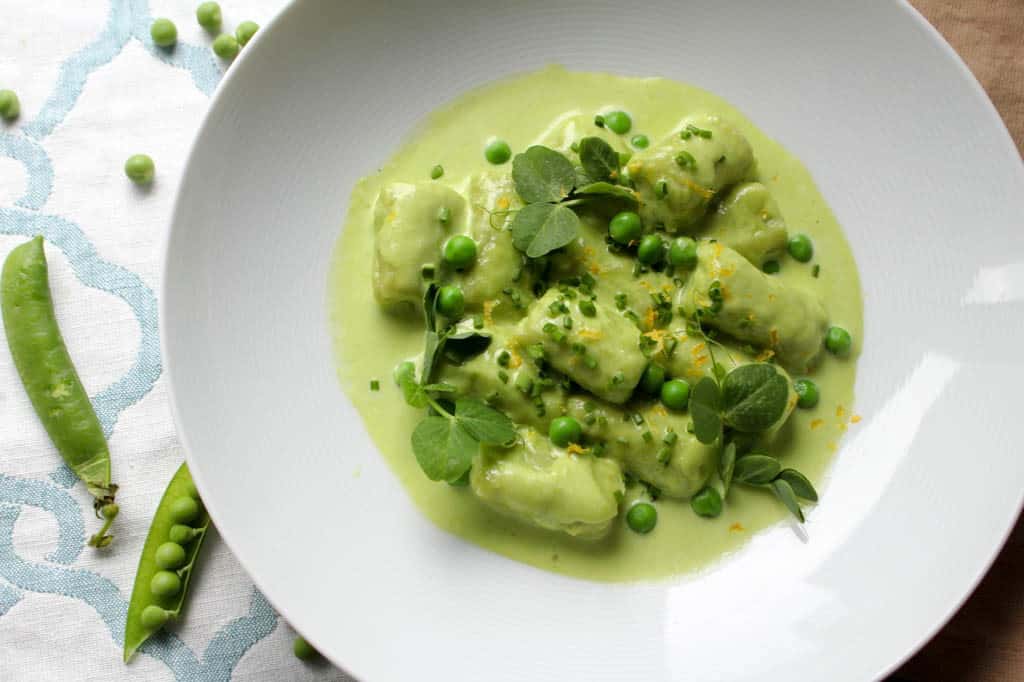

I wasn't very keen on peas growing up, but they've become one of my favorite parts about spring. They're a breeze to grow from seed and they find a spot in my garden year after year. Picked at just the right time, peas taste fresh, mild and oh-so-sweet. But left on the vine a little too long, and all of that natural sugar turns to starch, making them a bit less palatable.
So the neat thing about this recipe is that you don't need to worry about picking your peas at just the right moment, because the nice folks over at the frozen pea plant have already done that for you. That's right - we're using frozen peas, and I prefer them for just that very reason. They're picked right at the perfect point of ripeness and flash frozen on the spot. So unlike fresh peas, the frozen variety is always sweet, always readily available, always inexpensive, and always consistently so.
That being said, I like to use a few fresh peas and their tendrils for garnishing. They add beautiful depth and and a nice bit of texture to the dish, not to mention a gorgeous presentation. This is a fairly humble meal, but presents itself as being much, much fancier. What a looker!
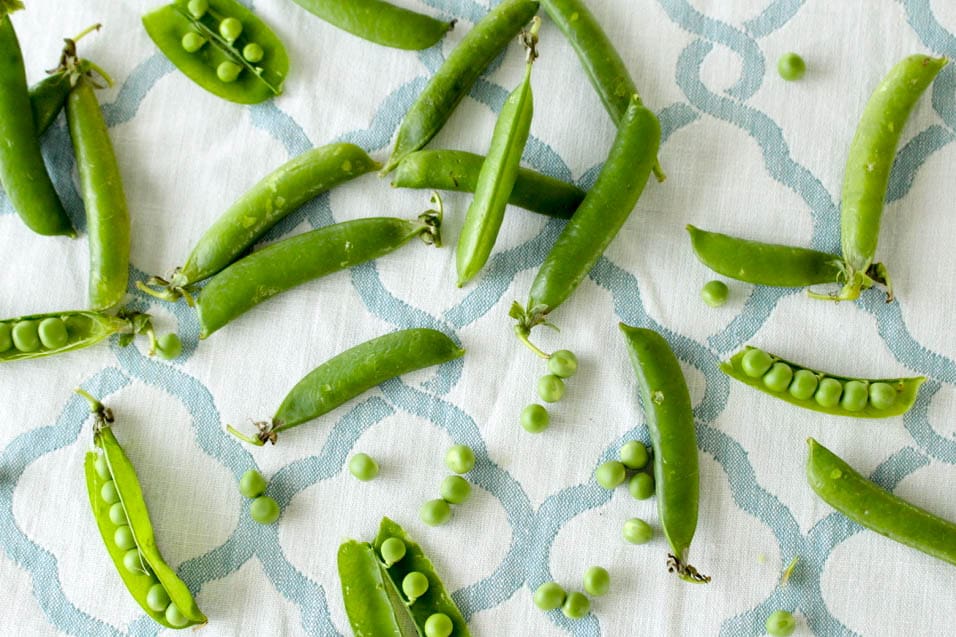
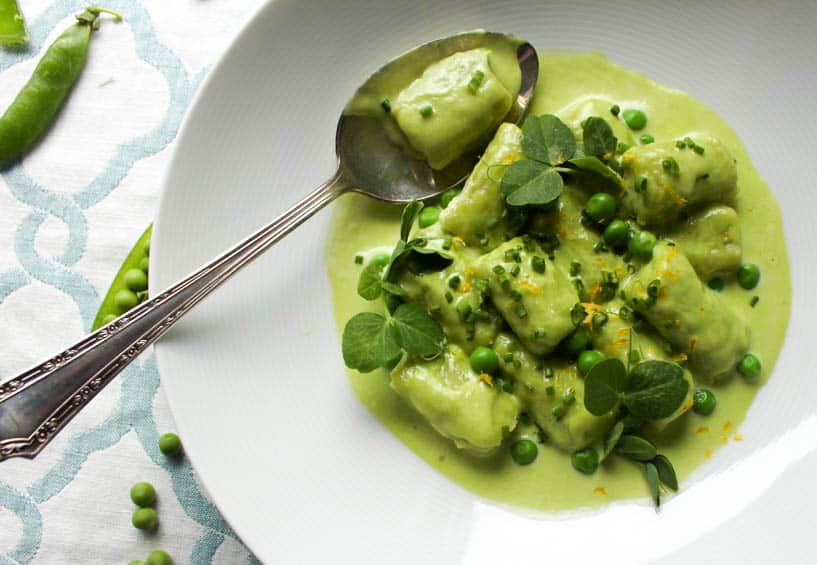

Anyone who's made gnocchi from scratch knows they're a labor of love. What you'll be saving in money, you'll be spending in time. And while the steps are by no means difficult, they are numerous, and you'll definitely dirty a few dishes in the process. But trust me, y'all. This one is worth it, one hundred percent.
We start out by roasting a few russet potatoes, they'll act as the base for the gnocchi. The peas have a fair amount of starch, but not enough to carry these little nuggets on their own. They need a bit of help, and potatoes are pro. Next, we want to make a bright emerald green puree out of the blanched peas, scallions and lemon. This is going to flavor and color both the gnocchi AND the sauce. Gotta love a 2-4-1.
After ricing the potatoes - a very important step - we add in some eggs and flour and mix it all together. But like so many other doughs we discuss on this blog, we must be careful not to over-mix. Over-mixing will cause the gnocchi to become tough and gluey, which is one of the most unappetizing things that can happen to a food. We want these to emulate pillows, not paste, so we must be mindful of our mixing.
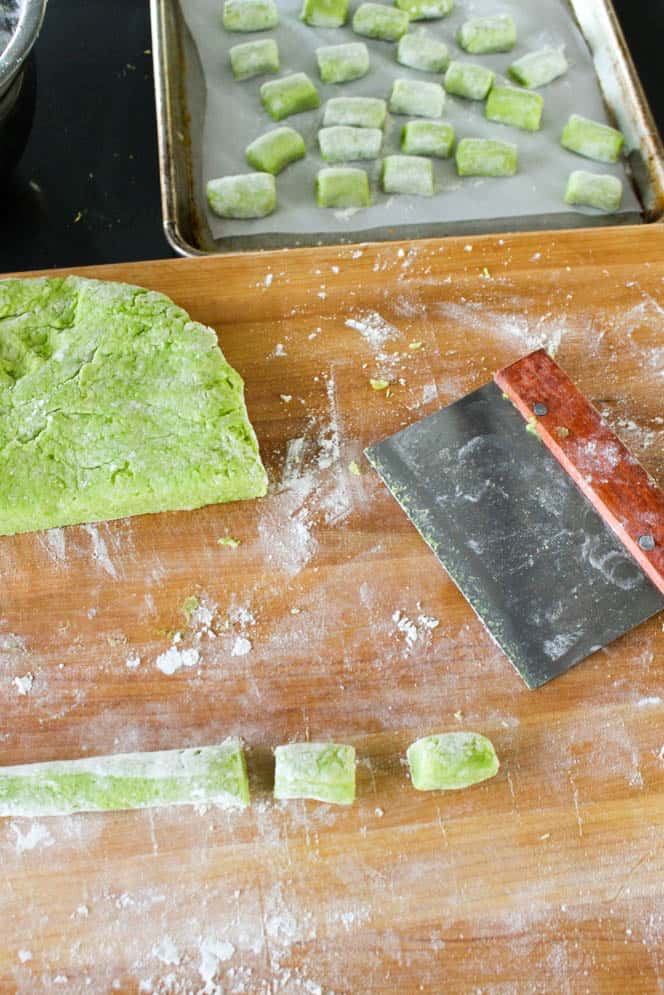
Next we roll them out and cut them into larger-than-usual dumplings. Why? Because I want them to be decidedly different than your standard, smaller gnocchi. Chaser thinks they're too big because he has to break them in half with a fork to take a bite. I think they're fine just the way they are. I tell Chaser that when he makes his gnocchi, he can make them whatever size he wants. Same thing goes for you. (Pro tip: the bigger the gnocchi, the less work.)
While they take a quick dip in a bath of boiling salty water, we'll reduce some heavy cream with garlic and tarragon. Sir in the pea cream and lemon juice, toss the gnocchi to coat, and you're on your way to pillowy, melt-in-your-mouth sweet pea heaven.
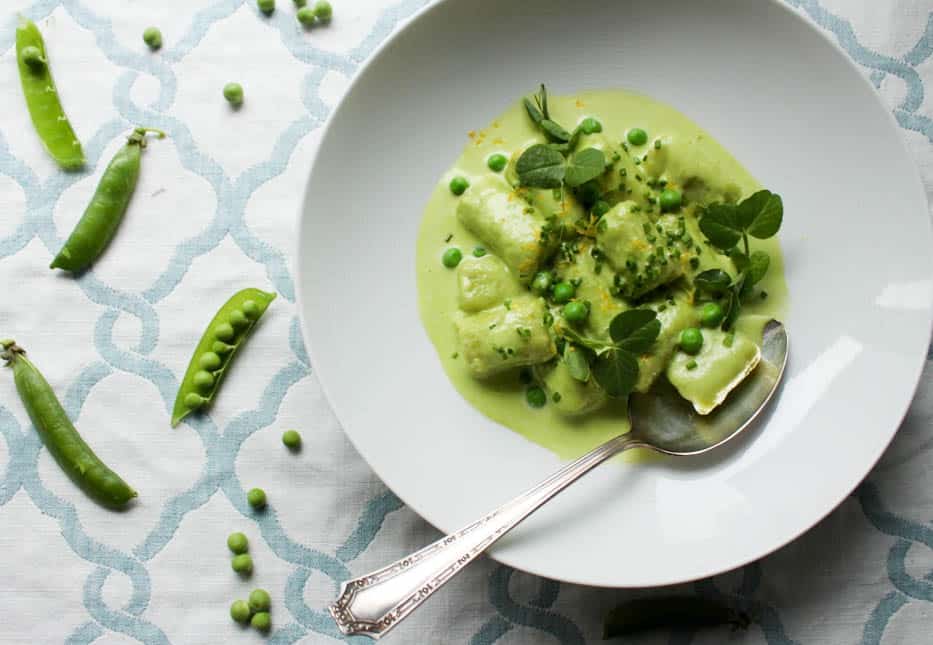
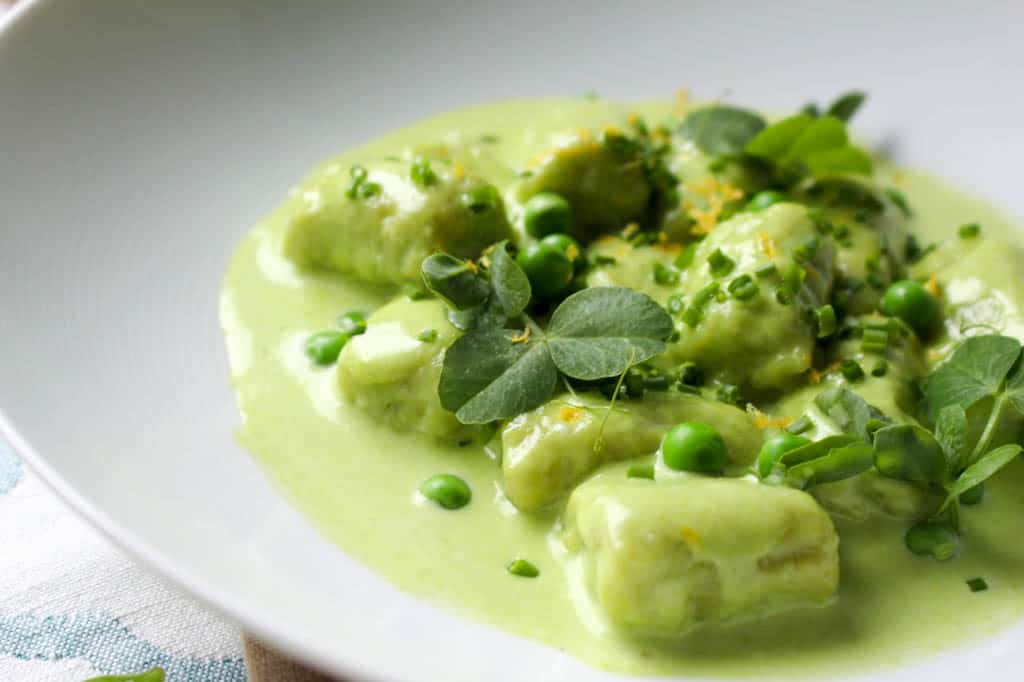
Want to Save This Recipe?
Enter your email & I'll send it to your inbox.
By submitting this form, you consent to receive emails from Coley Cooks.
Sweet Pea Gnocchi with Tarragon Pea Cream
Ingredients
For the Pea Puree
- 1 lb frozen peas
- 4 scallions
- 1 teaspoon salt
- zest from 1 lemon about 1 tbsp
For the Gnocchi
- 2 lbs russet potatoes can be slightly over 2 lbs, but no less
- 2 cups pea puree
- 2 large eggs
- 2 teaspoons salt
- white pepper to taste
- 2 cups all purpose flour
For the Sauce
- 3 cups heavy cream
- 2 cloves of garlic lightly crushed with the back of a knife
- 1 large sprig of tarragon plus 1 tablespoon chopped tarragon divided
- ¾ teaspoon salt
- white pepper to taste
- Remaining pea puree - about 1 cup
- Juice of 1 lemon
For the Finished Dish
- Blanched fresh peas
- Fresh pea tendrils
- Lemon zest
- minced chives and tarragon
Instructions
For the Pea Puree
- Place a large pot of water over high heat and bring it up to a boil and add a liberal amount of salt (it should taste like the ocean). While the water is heating up, get a bowl of ice water ready. When the water comes to a rolling boil, drop in the peas and the scallions and cook for 30 seconds. Immediately remove them to the ice bath. Reserve ¼ cup of cooking water.
- When the peas and scallions have cooled completely, drain and add them to a blender along with the salt, lemon zest and half of the reserved cooking water. Blend on high until it's completely smooth, adding a tiny bit more water if needed to help it blend. Run the puree through a fine mesh strainer to remove any remaining bits of skin. Set aside.
To Make the Gnocchi
- Preheat the oven to 375 degrees, lightly oil the outside of the potatoes, and poke a few holes in the skins. Bake for about an hour, or until the potatoes are fork tender. While the potatoes are still hot, remove the flesh and process through a food mill or potato ricer. Place the riced potatoes into a bowl and form a well in the center. Add the pea puree and crack both eggs in the well along with the salt and pepper. Use a fork to gently whisk it all together and start bringing in the potato. Sprinkle the flour all around, and very delicately begin mixing. When the dough starts to come together, dump it out on to a board and use a gentle folding technique to knead it a few times. Be very careful not to overmix. If the dough is very wet, you can add more flour in 1 tablespoon increments to get it to come together. The finished dough should be fairly tacky. Once the dough is just formed, set it aside.
- Prepare two sheet pans with a piece of parchment paper, then dust with flour. Dust a large board or counter top with flour, and cut off a small piece of dough. Roll into a thin log, then use a knife or bench scraper to cut out the gnocchi. You can make them any size you want, but I prefer a larger gnocchi for this dish.
- Place the gnocchi on the prepared sheet pans, being careful not to let them touch. Let the gnocchi rest for about 20-40 minutes before cooking.
For the Sauce
- Heat the heavy cream, garlic, and tarragon sprig in a large saucepan and bring to a boil. Cook until the cream reduces by half, about 10 minutes. It should nicely coat the back of a spoon. Remove the garlic and the tarragon. Season with salt and pepper.
Assembly
- Bring a large pot of water to a rolling boil and liberally season with salt (again - we want ocean water!). Working in batches of two or more, drop in the gnocchi and cook wait for them to float. Once they float, allow them to cook for 1-2 minutes longer.
- While the gnocchi are cooking, add the remaining pea puree, lemon juice and chopped tarragon to the sauce, stir and keep it over low heat. If it cooks too long or high, the sauce will turn from green to brown (but will still taste fine).
- Drain the gnocchi well, then add to the sauce and toss to coat. Adjust seasoning if necessary. Spoon the gnocchi on to a plate and garnish with a few blanched peas, randomly placed pea tendrils, and a shower of lemon zest, chives and chopped tarragon. Serve immediately.
Notes
- The dough can be prepared in advance, shaped into gnocchi, frozen on sheet pans, and stored in plastic bags in the freezer. They can be cooked from frozen, but will take an additional 3 or so minutes to cook. Pea cream can also be frozen - just defrost before using it in the recipe.
- This recipe can easily be cut in half.
- Tarragon is my preferred herb in this recipe, but basil, mint, lemon thyme, or your favorite herb would work nicely as well.
Nutrition
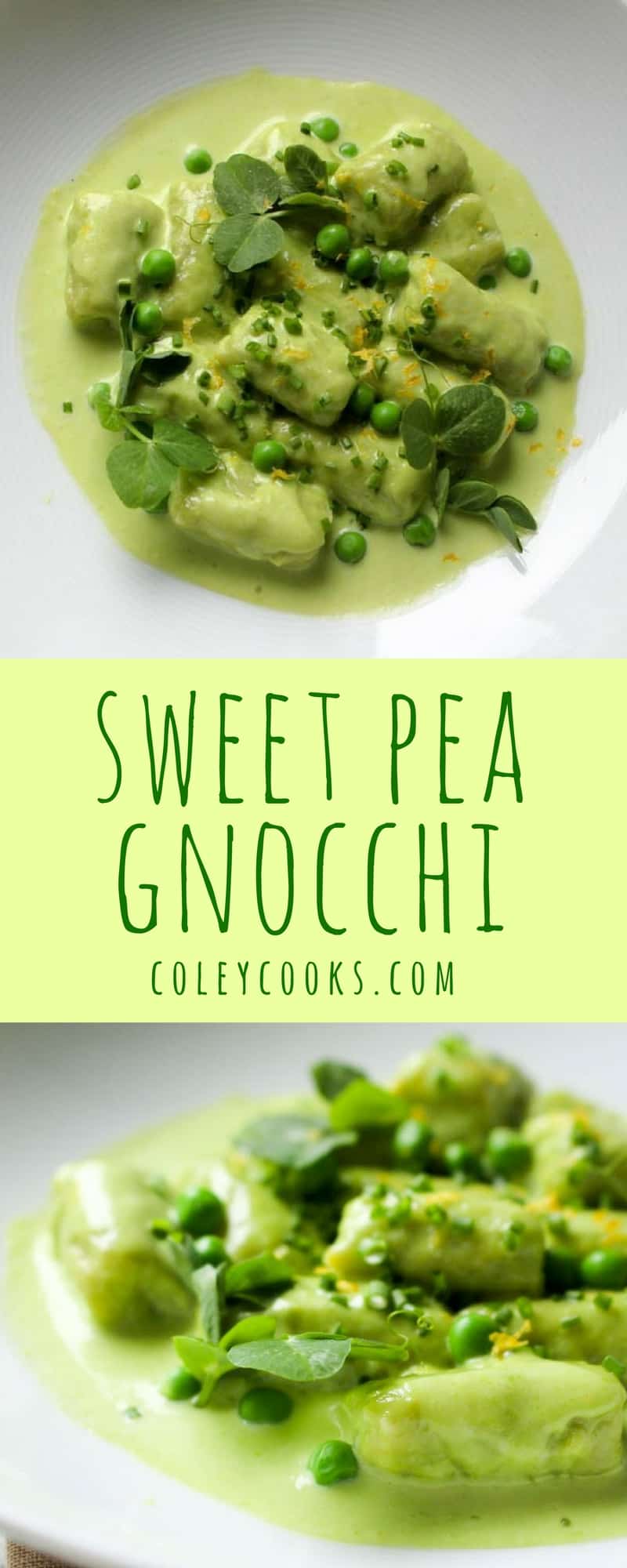


Ahh I wish I had a knack for gardening. I'm afraid to try, especially with the heat down here in Florida. Any tips for me?!? This gnocchi sounds amazing, it's one of my favorite foods and I order it often when I'm out for Italian. Never had a pea version before though, how creative!
You have to give gardening a shot! Peppers and tomatoes do really well in the heat! I'll bring a little something to get you started today 😉